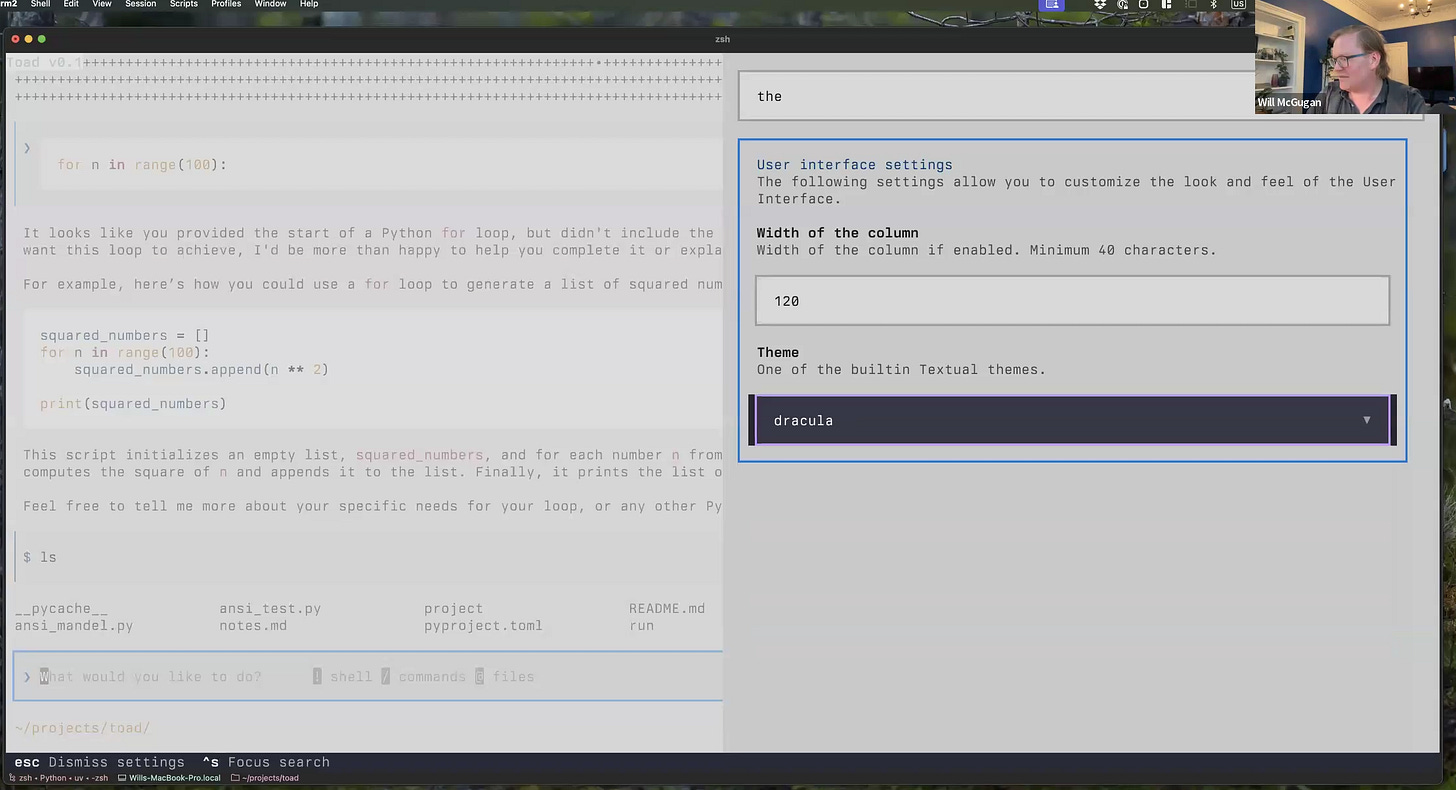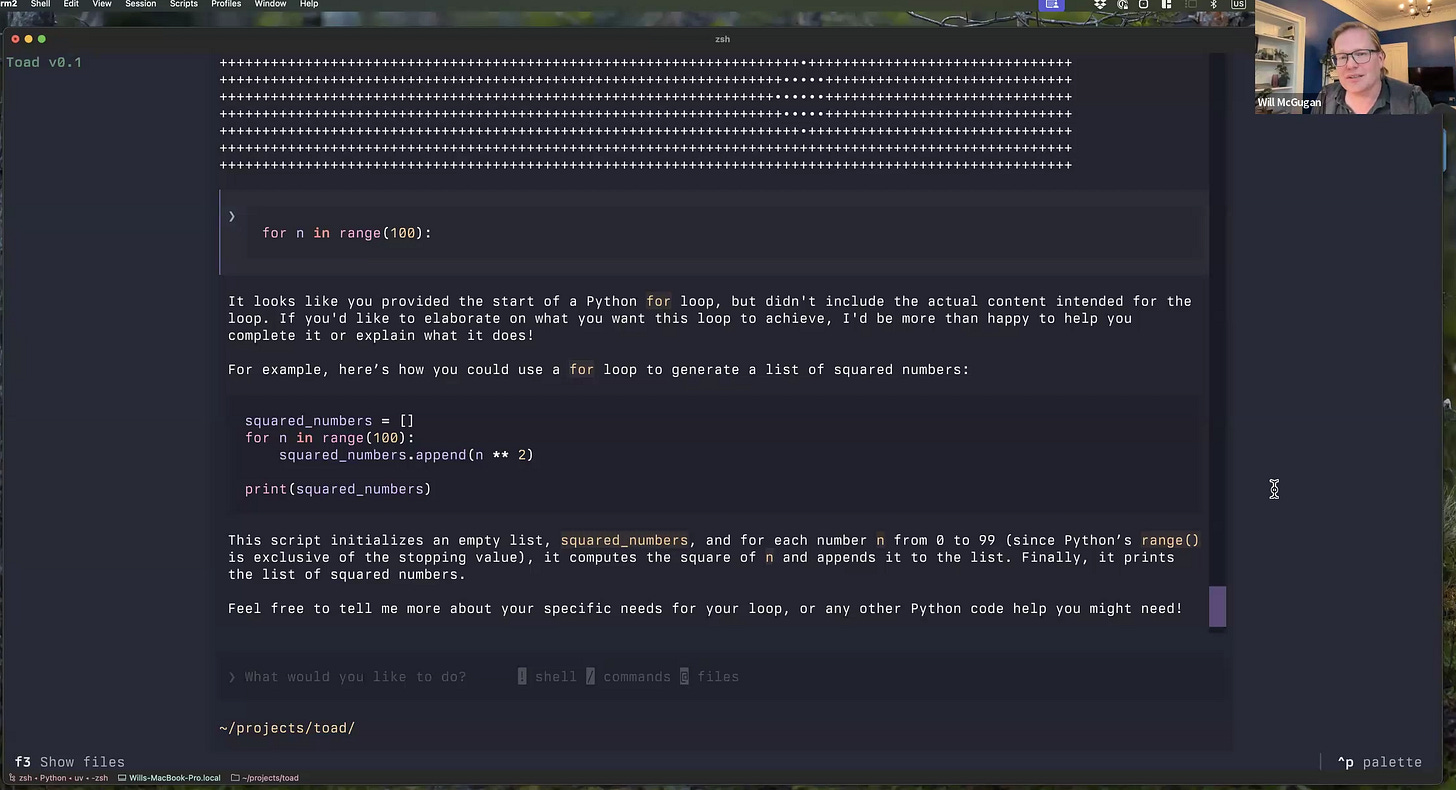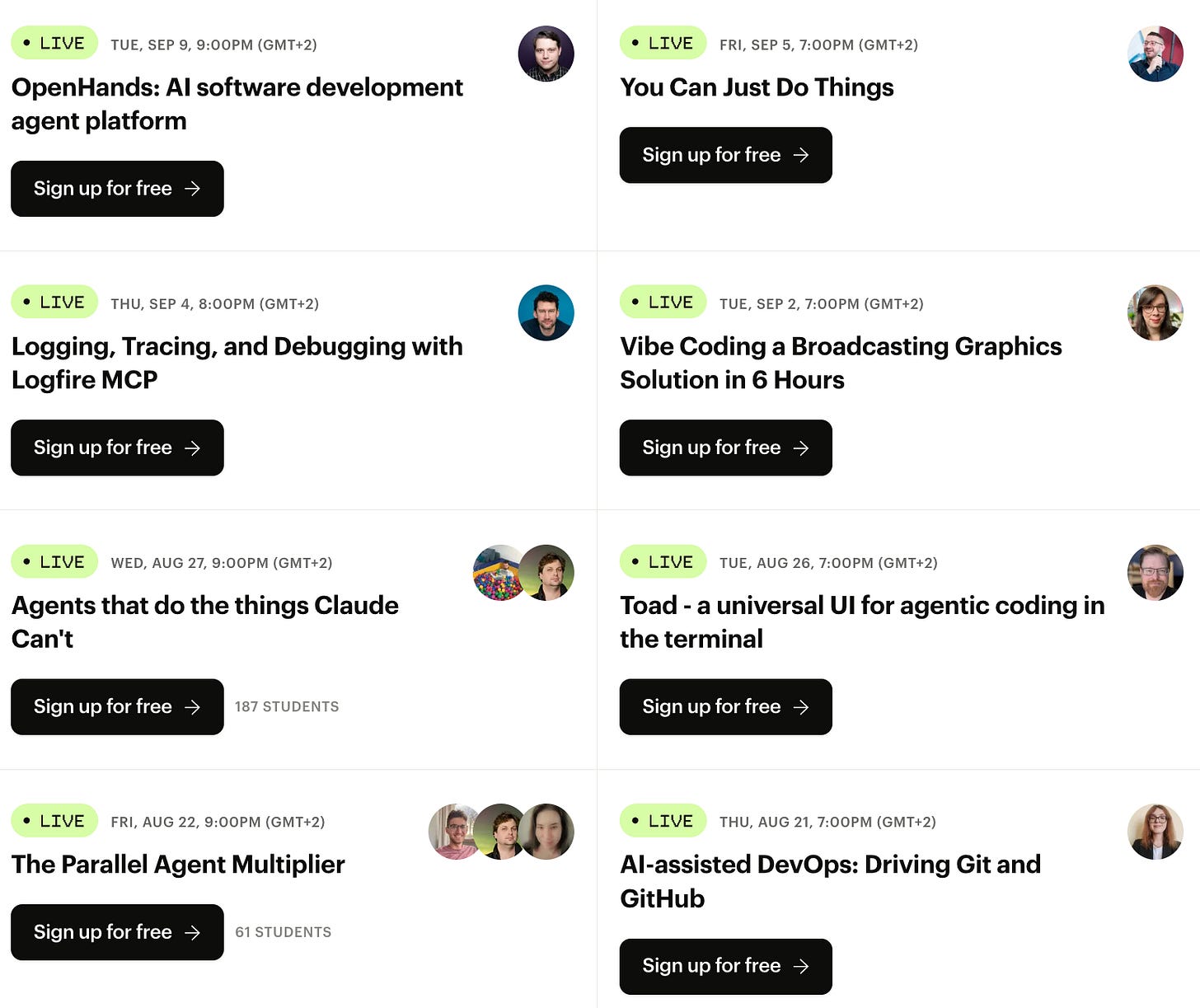Toad: A Universal UI for Agentinc Coding in the Terminal
Lightning Talk with Will McGugan
Will McGugan, creator of the popular Python terminal UI libraries Rich and Textual, presented Toad — a new universal terminal interface designed to provide a superior user experience for AI coding assistants. In a recent talk hosted by Eleanor on Elite AI Assisted Coding, Will demonstrated how his years of terminal UI expertise could solve the interface problems plaguing current AI coding tools.
Who is Will McGugan?
Will McGugan is a full-stack software developer and Python expert who has become synonymous with beautiful terminal interfaces in the Python ecosystem. He's the creator of Rich, a Python library for rich text and beautiful formatting in the terminal, and Textual, a sophisticated TUI (Text User Interface) framework that brings modern application development patterns to the terminal. His work has transformed how developers think about terminal output, making it possible to create visually appealing and interactive terminal applications with Python.
Previously the founder and CEO of Textualize, a company focused on building terminal applications, Will has spent over five years obsessing over terminal interfaces and pushing the boundaries of what's possible in text-based environments. His libraries have become essential tools for Python developers worldwide, and his expertise in terminal rendering techniques positions him uniquely to address the interface challenges facing the current generation of AI coding assistants.
The Problem with Current AI Terminal Interfaces
Will identified several critical issues with existing AI coding tools from major tech companies. Despite the surge in terminal-based AI applications, most suffer from fundamental user experience problems that make them frustrating to use.
"I found myself dismayed because a lot of techniques that I'd either developed or rediscovered weren't being employed in these apps from big tech. You don't get a very nice user experience. You get flicker, you can't interact with the content. The editor, where you put your prompt in, doesn't have many features. You can't select text and doesn't syntax highlight very well."
The root cause, Will explained, lies in how these tools update the terminal screen. Tools like Claude Code and Gemini CLI use the terminal's scrollback buffer, which requires deleting and rewriting entire screens of content for even minor updates. This approach causes the characteristic flickering that users experience and prevents meaningful interaction with previously generated content.
Introducing Toad: A Universal Frontend
Toad represents a different approach to AI coding interfaces. Rather than building yet another complete AI coding solution, Will focused on creating a universal frontend that can connect to any AI backend service.
"Think of it as a universal interface. If we type, so we can type a prompt and type hello, that just gets sent to the LLM. Hello, how can I assist you today? But you can also just go ahead and type shell commands. It'll figure it out from the contents."
During the demonstration, Will showcased several key features that set Toad apart:
Flicker-Free Rendering
By using the terminal's alternate buffer mode — a matrix of individually updatable characters — Toad eliminates the flickering that plagues other tools. This technique, commonly used by terminal editors and TUI applications, allows for smooth updates without redrawing entire screens.
Rich Text Interaction
Unlike existing tools where users can only interact with the most recent output, Toad treats the entire conversation as a living document. Users can navigate through all generated content, select text with mouse or keyboard, and perform actions on any code block or text segment.
"I can navigate this window and I can select text. I can use this cursor to go through the content. So you can imagine being able to move through. It's kind of a live document."
Advanced Prompt Editing
The prompt editor in Toad functions as a competent text editor with features missing from other tools:
Multi-line editing with proper syntax highlighting
Text selection and manipulation
Automatic detection of code fences for multi-line input
Smart mode switching between prompts, shell commands, and file navigation
Integrated File Navigation
Will demonstrated multiple ways to work with files directly within the interface. Users can invoke a fuzzy file searcher with the @ symbol, browse a file tree with F3, or reference files directly in prompts. This integration addresses a common pain point where users must constantly switch between their AI tool and file system.
The Notebook-Inspired Approach
When asked about the notebook-like appearance of Toad's interface, Will confirmed the inspiration was intentional. He recognized that the conversational history and generated content have inherent value beyond just the final code output.
"I want to build like a living document so that whilst you're developing software, okay, you can write files, commit files, et cetera. But you've also got this content you've generated, which is useful in its own right and valuable."
This approach particularly benefits newcomers to programming who need to learn from AI interactions as much as they need to generate code. The persistent, navigable conversation history becomes a learning resource that traditional AI coding tools discard.
Technical Foundation: Building on Textual
Toad leverages Will's Textual framework, which he developed over the past five years. This foundation allowed him to create a sophisticated interface in just a few weeks that already surpasses the user experience of tools from major tech companies.
"It took me a couple of weeks to get the first revision of Toad and then I think it's been like another four weeks after that and already it's a beautiful front end. It beats big tech offerings."
The advantage of using Textual becomes clear when considering the alternative. Will estimated that even well-funded teams would need significant time to build comparable terminal UI infrastructure from scratch. By using an existing, battle-tested framework, Toad could focus on user experience rather than low-level terminal manipulation.
A Universal Protocol for AI Agents
Looking forward, Will outlined his vision for Toad as a universal frontend for various AI services. Rather than competing with big tech on AI capabilities, he plans to create a protocol that allows any AI backend to plug into Toad's interface.
"I'm going to create a protocol which will allow a back-end process to talk to them. So if you imagine at some point in the future, you launch Toad, you probably get some kind of interface listing all your agents. These could be genetic coding, but they could also be specialized chatbots, and they could be even more specialized tools."
This approach separates concerns effectively — AI companies can focus on improving their models and agents while Toad provides the optimal user interface. Will suggested this could even enable specialized AI tools for specific tasks, like a "Python buddy" focused solely on writing idiomatic Python code.
Open Source Future and Community Involvement
Will confirmed that Toad will be open source, though he's waiting until it reaches a certain level of completeness before releasing it publicly. He emphasized that open source is essential for the project's success.
"Something like this could not be successful unless it was open source. If it was closed source, I just don't have the clout to get people to use it. If it's closed source, I couldn't go to big tech and ask them to use my closed source front end. They just wouldn't do it."
For those interested in following the project's progress, Will actively shares updates on Twitter and welcomes feedback to help shape the UI. He's also seeking sponsorship, particularly from big tech companies who stand to benefit from a better terminal interface for their AI services.
The Bigger Picture
Toad represents a refreshing approach to the current AI coding tool landscape. While major tech companies race to build similar, competing products, Will identified an opportunity to create something that benefits everyone — a superior interface that any AI service can use.
"There's a lot of wheels being reinvented right now. I wish they'd used Textual from scratch because I've been building this thing. It didn't take me long to get to this stage."
By focusing solely on the frontend experience and making it universal, Toad could leapfrog the current offerings from big tech. As Will noted, the comparison to web development is apt — developers don't build new browsers for each web application, so why should every AI coding tool rebuild the terminal interface from scratch?
The demonstration showed that even in its current early state, Toad already provides a more pleasant and productive experience than existing tools. With features like flicker-free rendering, comprehensive text interaction, and notebook-style persistent conversations, it addresses the pain points that make current AI coding tools frustrating to use. As the project moves toward its open source release, it has the potential to become the standard interface for terminal-based AI interactions, benefiting both users and AI service providers alike.
👉 Visit Will McGugan’s GitHub (and sponsor his work)
👉 More upcoming Lightning Talks at Elite AI Assisted Coding on Maven













